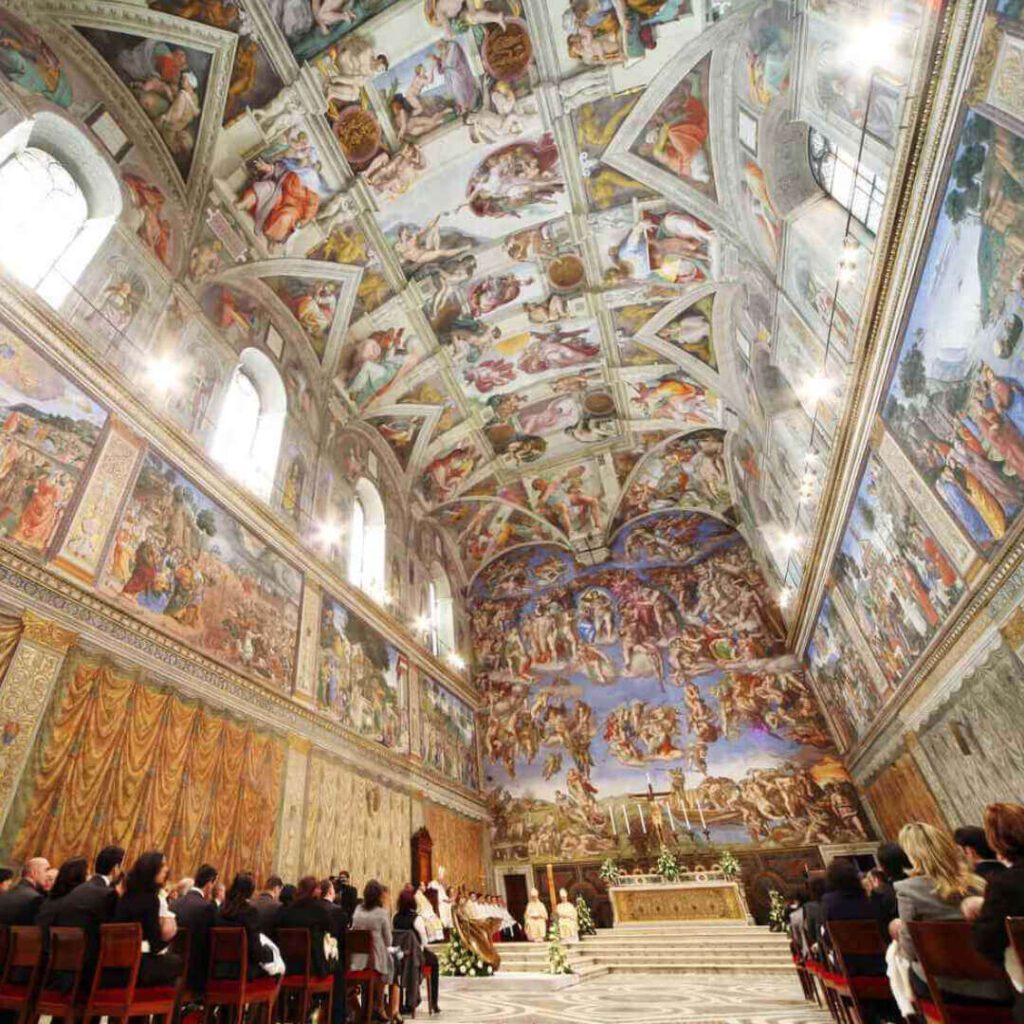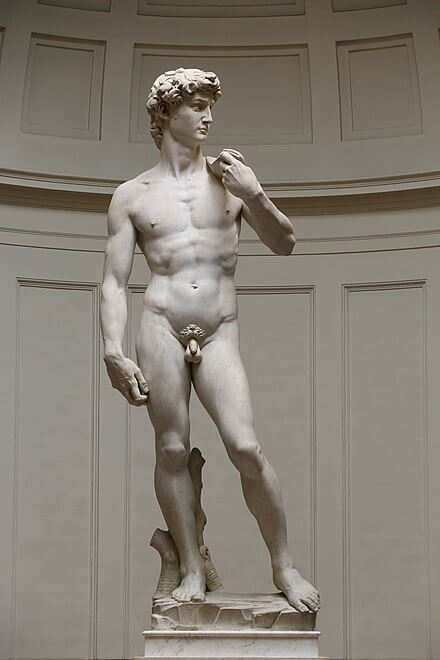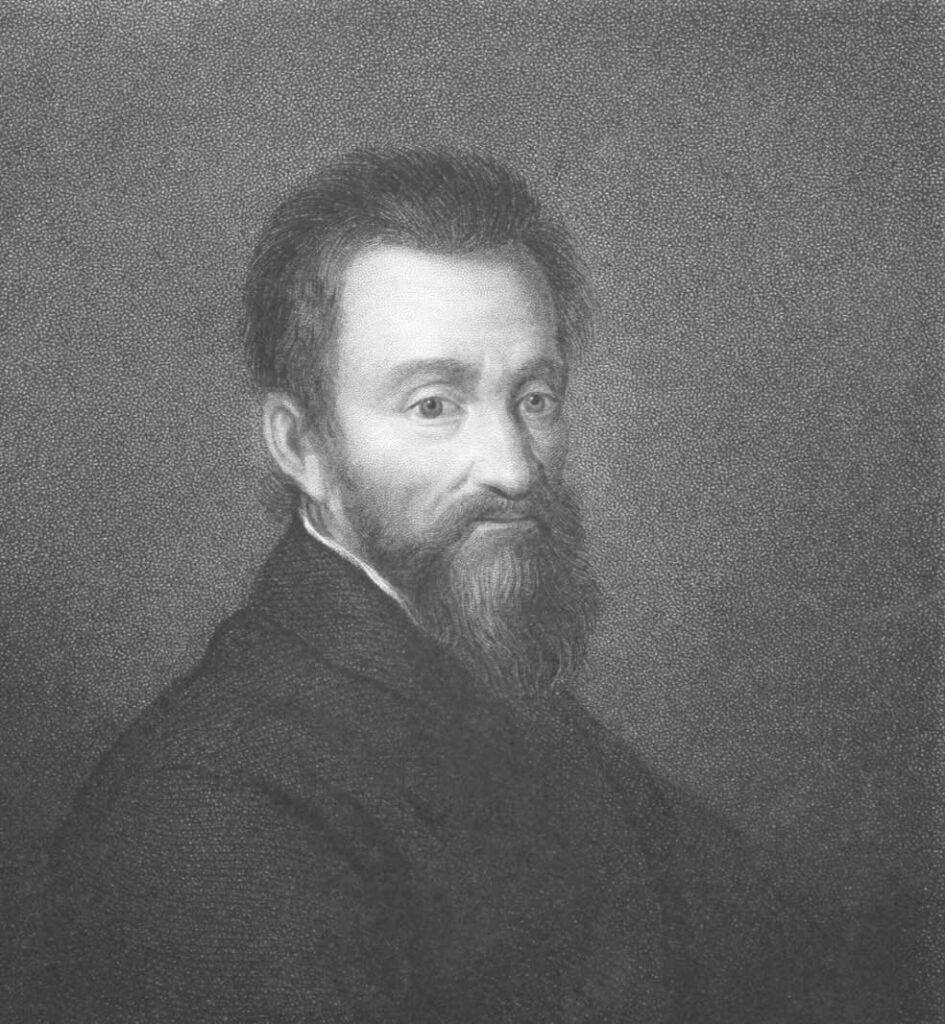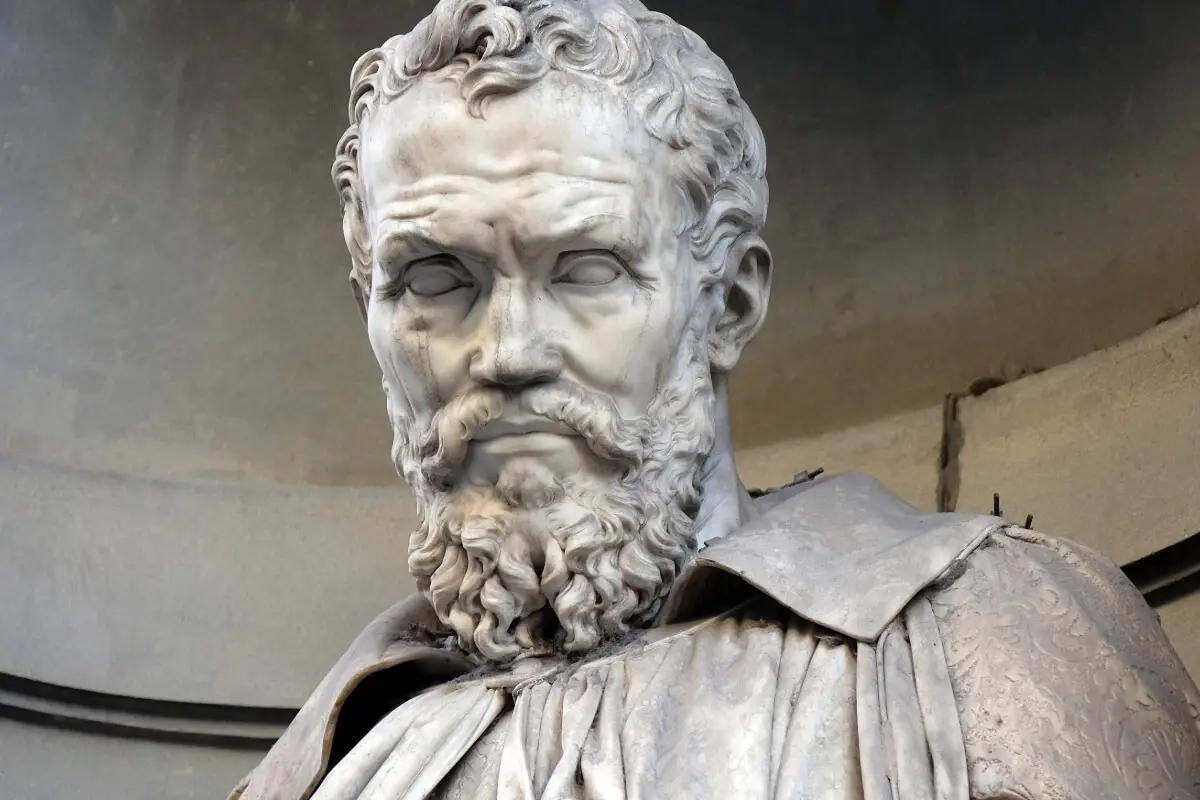Michelangelo Buonarroti remains one of history’s unparalleled artistic figures, an archetype of creative brilliance whose work continues to resonate through the centuries. From the dizzying heights of the Sistine Chapel Ceiling to the sublime form of the Statue of David, Michelangelo’s output not only redefined the ambit of aesthetic expression but also set a new bar for the artist as an entrepreneur and brand in the complex web of Renaissance patronage.
As we journey through the master’s most iconic creations, we uncover the layers of genius that have cemented his works as cornerstones of cultural and commercial marvels and explore the lasting impact of his oeuvre that still shapes our understanding of art’s potential to influence the world.
Table of Contents
- The Sistine Chapel Ceiling
- The Statue of David
- The Last Judgment
- Michelangelo’s Architectural Contributions
- Michelangelo’s Influence on Modern Branding
- Related Questions
The Sistine Chapel Ceiling
Michelangelo’s Sistine Chapel: A Masterstroke in Art and Business Savvy

When Michelangelo took the reins on the Sistine Chapel’s ceiling, he wasn’t just painting; he was revolutionizing the business of art. This isn’t simply about biblically themed frescoes—it’s about setting a precedent for the art world and redefining the value of artists and their work in society.
Firstly, let’s talk about impact. The sheer scale and ambition of the Sistine Chapel project set a new standard for what could be achieved in the world of fine arts. The boldness of taking on such a colossal task and executing it with unrivaled skill and creativity shifted the goalposts. It told artists everywhere: “Aim high, think big, create without limits.”
But it wasn’t just about inspiration. Michelangelo’s masterpiece commanded the attention of the wealthiest patrons. Before this, artists were often seen as mere craftsmen. The Sistine Chapel changed that. It showed that artists could be visionary leaders capable of steering monumental projects to completion. The result? A newfound respect for artists allowed them to ask for more freedom, credit, and cash.
Michelangelo’s work also turned the Sistine Chapel into what we would call a ‘destination brand. People came from far and wide to witness the grandeur, and they still do. This foot traffic translated into revenue for the Vatican and the entire Roman economy, appraising the concept of cultural capital in the most literal sense.
And let’s not overlook the business-smart approach of the commissioner, Pope Julius II. By hiring a star like Michelangelo, he wasn’t just investing in religious art but aligning himself with a celebrity. It was one of the earliest examples of influencer marketing, tapping into Michelangelo’s fame to elevate his status and that of the Church.
In essence, the Sistine Chapel wasn’t just a job well done; it was a move that shook the foundations of artistic enterprise. It’s a telling reminder—whether in art, business, or any industry—that when you combine bold vision with exceptional talent and treat creators with the esteem they deserve, you’re not just crafting masterpieces but sculpting commerce’s future.
The Statue of David
Crafting Genius: The Statue of David’s Market-Molding Marvel

In high-stakes artistry, where the elegant brush stroke meets the masterful chisel strike, few creations command the awe-inspired respect that the Statue of David does. A masterwork like David’s goes beyond mere artistic prowess—it’s a testament to the power of branding, a symbol of cultural influence, and an arbitrator of fine art’s value in the marketplace.
The Statue of David, sculpted by the iconic Michelangelo, isn’t just stone hewn into form—it’s a marketplace phenomenon that reinvented the standard for aesthetic excellence. To grasp the essence of David’s brilliance, one must look at the fusion between art and commerce, the phenomenon of strategic product placement in an era predating modern marketing playbooks.
Consider the audacity and ingenuity it takes to create a titan of the art world. David stands tall as an archetype of innovation—in its time, a Start-Up of the arts if you will. Michelangelo’s David broke the mold, quite literally, with its larger-than-life scale and unprecedented anatomical precision. It showcased what can happen when an unwavering commitment to quality meets an unquenchable thirst for revolutionizing a sector.
The positioning of the Statue of David, a marvel in marble, within Florence catapulted the locale to new heights of cultural richness, enhancing its global reputation. Captivating the attention of art connoisseurs and novices alike, David rapidly became a global spectacle, underlining the significance of strategic placement and the pull of a flagship product. In securing the commission, Michelangelo not only elevated his brand but solidified the status of Florence as a hub of Renaissance glory.
The ripple effect of David’s creation was marketplace alchemy—suddenly, art turned from mere decoration to a potent form of capital. The savvy investor of the times knew the value vested in fine art could translate into cultural and economic capital. Thus, the Statue of David didn’t just convince the market of its worth; it was a game-changer, a disruptor, that challenged other artists and patrons to raise the bar.
Moreover, David’s prominence shaped not just art but the business of art. The allure and prestige it bequeathed were potent tools that could be leveraged for negotiation, whether in wooing affluent patrons or setting a precedent for artistic commissions. Its influence resonated through the spheres of power, wealth, and taste, becoming its own currency among the elite. The art world never looked the same.
Indeed, the Statue of David is a magnificent symbol of aesthetic and business acumen. Its creation strikes at the core of what brilliant art combined with sharp commercial instincts can achieve. To behold David is to see not just a marvel in sculpture but a pivotal force in the world of creative commerce—a beacon for the ambitious, a challenge to the status quo, and ultimately, an emblem of brilliance in the art as business.
The Last Judgment

As we delve into The Last Judgment’s masterful creation, we find a brilliant intersection of artistic genius and sharp business acumen. Michelangelo’s magnum opus in the Sistine Chapel is not merely an emblem of Renaissance artistry; it signifies an astute understanding of market dynamics and strategic client management.
In commissioning, The Last Judgment, Michelangelo and Pope Paul III Farnese demonstrate a keen awareness of the power of brand extension. The Sistine Chapel’s ceiling had already forged an unparalleled brand of cultural significance. With The Last Judgment, they leveraged this brand to further solidify the chapel’s and, by extension, the Vatican’s undisputed reputation as an epicenter of divine artistry.
Integrating The Last Judgment into Michelangelo’s portfolio exemplifies a masterclass in creating a compelling product line. Each fresco functions as an independent marvel, yet together, they form a cohesive experience that elevates the artist’s market value. Michelangelo dexterously expands his artistic repertoire while satisfying the church’s desire for illustrious religious narratives.
Furthermore, Michelangelo’s strategic negotiations for autonomy in his creative process highlight a high-stakes business maneuver. By securing the trust and investment of his clients, he didn’t just sell a service; he ensured creative control, preserving the integrity and uniqueness of his brand. Such a level of trust implicitly communicates to the market that his services warrant premium value, a tactic that today’s leading entrepreneurs mirror in securing venture capital or pitching high-value propositions.
The Last Judgment also serves as a masterstroke of client relationship management. By delivering on a monumental scale, Michelangelo reassures his clientele of their wise investment, fortifying patron loyalty and encouraging word-of-mouth referrals that are gold in any business.
Lastly, The Last Judgment‘s evocative impact on viewers was a calculated move to sustain the traffic to the Sistine Chapel, ensuring a lasting economic benefit. Like today’s disruptors who craft experiences that drive user engagement and repeat business, Michelangelo recognized the long-term value of creating a work that compels continuous visitation and discourse.
In conclusion, Michelangelo’s execution of The Last Judgment exemplifies the understanding of an entrepreneur who grasps the importance of brand equity, client satisfaction, and product lineup expansion. His legacy is a testament to the inherent synergy between creativity and commerce, an eternal benchmark for innovation and strategic business acumen.
Michelangelo’s Architectural Contributions
Innovating the Edifice: Michelangelo’s Architectural Disruption
In building and design, few names resonate as profoundly as Michelangelo. He is best known for his monumental sculptures and frescoes, it’s his architectural genius genuinely revolutionized the building industry. His concepts were not merely innovations but disruptions that have stood the test of time.
Consider the Laurentian Library, with its radical Mannerist style. Here, Michelangelo introduced a dramatic staircase that seemed to flow like lava — defying traditional formality with its expressive design. This was not architecture for architecture’s sake; it was architecture that demanded an emotional response, altering the very role of public spaces.
Further, look upon the Medici Chapel, where he integrated sculpture and architecture to an unprecedented degree, orchestrating a spatial narrative that serves function and aesthetics equally. His use of space, his management of light, and his intuitive grasp of structural integrity defied the norms. This was not just about constructing a building; it was about constructing an experience.
Perhaps his architectural contribution to St. Peter’s Basilica was the boldest. Handpicked to complete this daunting task, Michelangelo caused a stir in the building industry with his daring dome design. Today, the Basilica’s dome is considered the epitome of architectural achievement, a marvel that pushed the boundaries of engineering and aesthetics. This was not a mere building but a blend of fearless vision and meticulous science.
Michelangelo’s architectural flair had a profound ripple effect across the industry. He didn’t just create buildings; he crafted legacies. His signature approach to the built environment emphasized the totality of experience and the potency of the structure to engage, exhilarate, and withstand the scrutiny of time.
Transformational ideas often provoke resistance, yet Michelangelo’s architectural prowess did more — it inspired a shift in the industry, championing a belief in the limitless possibilities of space and form. His works embodied the Renaissance spirit, unlocking a consciousness that buildings were not mere shelters but profound expressions of human ingenuity.
In every stone laid and facade raised, Michelangelo’s architecture spoke a language of innovation that the building industry had never before heard. His disruption was such that it did not merely tweak the norms — it set new ones. The industry was forever changed as architects around the globe strove for the same symphony of form and function that he so masterfully composed.
It’s clear that Michelangelo did not just shape marble and frescoes — he shaped the very foundations of the building industry, leaving an indelible impact that stretches far beyond the ornaments of the Sistine Chapel, the contours of the Statue of David or the grandeur of St. Peter’s Basilica. His approach was a clarion call that continues to resonate through the centuries: Dare to disrupt, and the world will marvel at the foundations you lay.
Michelangelo’s Influence on Modern Branding
In the spirit of relentless innovation, it’s time to consider the masterful branding blueprint Michelangelo unwittingly left for modern enterprises. His techniques mirror today’s best practices with precision, offering a wealth of wisdom for those eager to craft a brand that stands the test of time.
Michelangelo’s organic use of storytelling through frescoes transcends religious narratives to deliver a potent tale of brand identity. He fostered a deep emotional connection with his audience, a principle modern marketers strive to emulate through multimedia storytelling campaigns. This storytelling prowess helped establish a distinct voice that resonates even in our digital age.
Networking before it had a name, Michelangelo capitalized on his relationships to amplify his brand. Entrepreneurs today can take a page from his book to harness the power of networking effectively, eventually building a circle of influence that sustains and propagates their brand’s presence.
A visionary’s visionary, Michelangelo pioneered personal branding, something entrepreneurs polish to a fine sheen today. He was his brand, and his brand was a beacon of quality, innovation, and unparalleled skill. Modern professionals amplify their brands through LinkedIn, TED talks, and industry conferences, capturing the essence of Michelangelo’s self-promotion mastery.
Furthermore, the maestro’s legacy underscores the criticality of adaptability and diversification—forever in pursuit of mastering uncharted territories, whether sculpture, painting, or architecture. Likewise, today’s giants like Amazon and Google consistently dive into new markets, underpinning the vital nature of versatility and growth in business.
Finally, Michelangelo’s intuitive understanding of the experiential—his works are not just seen but felt—aligns with the modern approach to immersive customer experiences. From Apple Stores to immersive Facebook ads, the goal is always to envelop the consumer in a captivating brand narrative, a method synonymous with the visceral experiences Michelangelo crafted centuries ago.
Without a doubt, entrepreneurs and marketers alike can draw a straight, unbroken line from the wisdom of Michelangelo’s brand-building finesse to the avant-garde strategies that dominate the modern marketplace. His legacy, artistically and entrepreneurially, endures as a testament to the brilliant alignment of creativity and commerce. This blueprint can, and should be, adapted to carve a brand as enduring as the marble giants that continue to guard his genius.

The enduring legacy of Michelangelo is a testament to the transformative power of art and the unrelenting pursuit of excellence. His works transcend mere physical form to engage deeply with the psyche of humanity, challenging perceptions and inspiring innovation across boundaries of time and discipline.
Michelangelo’s approach to his art and life encapsulates a luxury brand’s quintessence—a harmonious blend of skill, foresight, and an indomitable spirit that still captivates and instructs. He was not just a master of the arts but also a forefather of modern branding, sculpting an identity that would endure as powerfully as the marble he carved, radiating an influence that reaches far beyond the gilded frames and vaulted ceilings of history.
Anita Louise Art is dedicated to art education, great artists, and inspiring others to find and create their art. We love art that uplifts and inspires. #ArtToMakeYouSmile! #ArtToMakeYouHappy!
If you are interested to see any of my art, you can find out more by clicking here. If you are interested in what inspires me and my paintings, you can discover more by clicking here.
We have a free newsletter and would love you to be part of our community; you can subscribe to the newsletter by clicking here. If you have any questions, I would be happy to talk to you. You can reach me, Anita, by clicking here.
Subscribe to our Anita Louise Art YouTube Channel with great videos and information by clicking here.
Join us for our podcast “5 Minutes With Art.” Spend just 5 minutes a week with us to discover and learn about great art and artists. You can find out more about our podcast by clicking here.
Related Questions
What Makes Jackson Pollock’s Art So Valuable?
Jackson Pollock was a brilliant and creative artist who was not afraid to try new techniques with art. He is known for being a founder of Abstract Expressionism and the gestural technique, also known as action painting. He never saw much success in his lifetime, but today his painting fetch millions of dollars and are considered extremely valuable.
By clicking here, you can discover more by reading What Makes Jackson Pollock’s Art So Valuable?
Did They Use An Original Jackson Pollock Painting In Ex Machina Or A Replica?
They would have used a copy of this painting No 5 (1948) as the painting was sold by David Geffen, a Hollywood producer, and film studio executive, for over $140 million USD in 2006. Geffen would have sold the painting long before the movie was produced, and no respectable art collector would place such a valuable work of art on a film set or studio.
By clicking here, you can learn more by reading Did They Use An Original Jackson Pollock Painting In Ex Machina Or A Replica?
How Much Is The Jackson Pollock Painting Worth In The Movie “The Accountant”?
We do not know precisely how much the Jackson Pollock Free Form painting is worth, but we know that it is owned by the Museum of Modern Art in New York City, and the painting in the movie The Accountant is a reproduction or copy. We know that similar Jackson Pollock paintings have sold for over $100 million. So we know that Jackson Pollock’s paintings are precious in today’s art market.
By clicking here, you can learn more by reading How Much Is The Jackson Pollock Painting Worth In The Movie “The Accountant”?


